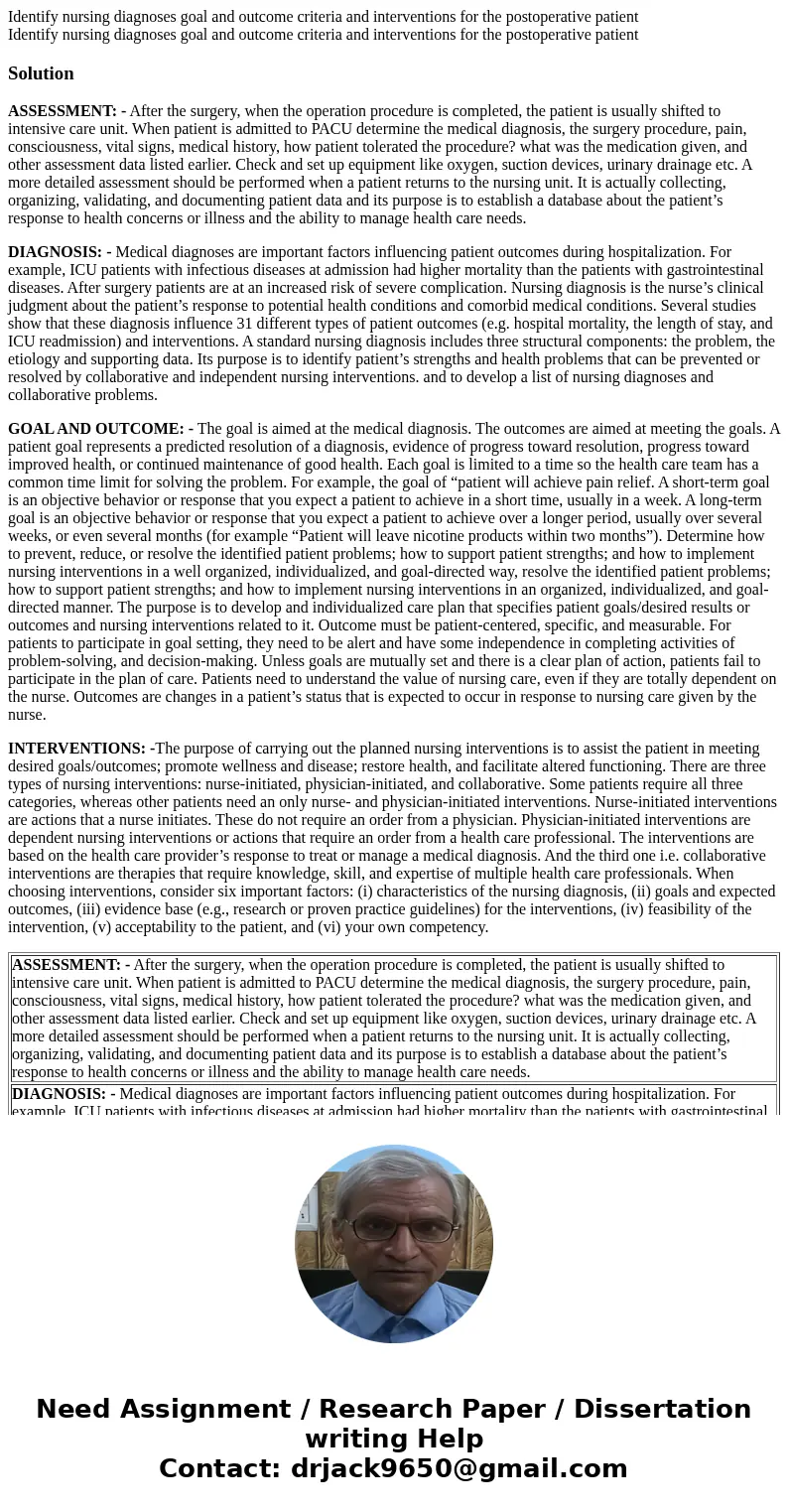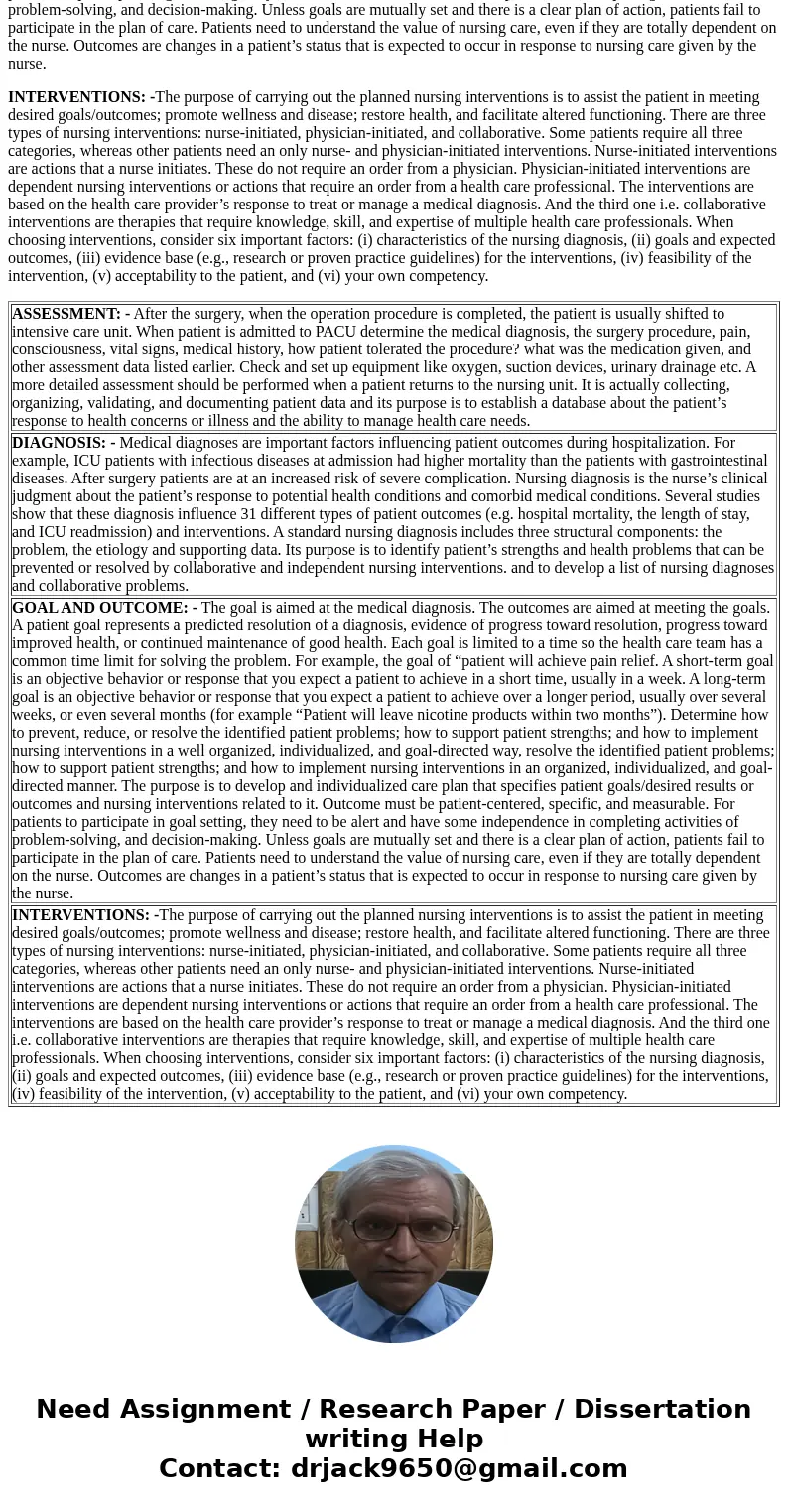Identify nursing diagnoses goal and outcome criteria and int
Solution
ASSESSMENT: - After the surgery, when the operation procedure is completed, the patient is usually shifted to intensive care unit. When patient is admitted to PACU determine the medical diagnosis, the surgery procedure, pain, consciousness, vital signs, medical history, how patient tolerated the procedure? what was the medication given, and other assessment data listed earlier. Check and set up equipment like oxygen, suction devices, urinary drainage etc. A more detailed assessment should be performed when a patient returns to the nursing unit. It is actually collecting, organizing, validating, and documenting patient data and its purpose is to establish a database about the patient’s response to health concerns or illness and the ability to manage health care needs.
DIAGNOSIS: - Medical diagnoses are important factors influencing patient outcomes during hospitalization. For example, ICU patients with infectious diseases at admission had higher mortality than the patients with gastrointestinal diseases. After surgery patients are at an increased risk of severe complication. Nursing diagnosis is the nurse’s clinical judgment about the patient’s response to potential health conditions and comorbid medical conditions. Several studies show that these diagnosis influence 31 different types of patient outcomes (e.g. hospital mortality, the length of stay, and ICU readmission) and interventions. A standard nursing diagnosis includes three structural components: the problem, the etiology and supporting data. Its purpose is to identify patient’s strengths and health problems that can be prevented or resolved by collaborative and independent nursing interventions. and to develop a list of nursing diagnoses and collaborative problems.
GOAL AND OUTCOME: - The goal is aimed at the medical diagnosis. The outcomes are aimed at meeting the goals. A patient goal represents a predicted resolution of a diagnosis, evidence of progress toward resolution, progress toward improved health, or continued maintenance of good health. Each goal is limited to a time so the health care team has a common time limit for solving the problem. For example, the goal of “patient will achieve pain relief. A short-term goal is an objective behavior or response that you expect a patient to achieve in a short time, usually in a week. A long-term goal is an objective behavior or response that you expect a patient to achieve over a longer period, usually over several weeks, or even several months (for example “Patient will leave nicotine products within two months”). Determine how to prevent, reduce, or resolve the identified patient problems; how to support patient strengths; and how to implement nursing interventions in a well organized, individualized, and goal-directed way, resolve the identified patient problems; how to support patient strengths; and how to implement nursing interventions in an organized, individualized, and goal-directed manner. The purpose is to develop and individualized care plan that specifies patient goals/desired results or outcomes and nursing interventions related to it. Outcome must be patient-centered, specific, and measurable. For patients to participate in goal setting, they need to be alert and have some independence in completing activities of problem-solving, and decision-making. Unless goals are mutually set and there is a clear plan of action, patients fail to participate in the plan of care. Patients need to understand the value of nursing care, even if they are totally dependent on the nurse. Outcomes are changes in a patient’s status that is expected to occur in response to nursing care given by the nurse.
INTERVENTIONS: -The purpose of carrying out the planned nursing interventions is to assist the patient in meeting desired goals/outcomes; promote wellness and disease; restore health, and facilitate altered functioning. There are three types of nursing interventions: nurse-initiated, physician-initiated, and collaborative. Some patients require all three categories, whereas other patients need an only nurse- and physician-initiated interventions. Nurse-initiated interventions are actions that a nurse initiates. These do not require an order from a physician. Physician-initiated interventions are dependent nursing interventions or actions that require an order from a health care professional. The interventions are based on the health care provider’s response to treat or manage a medical diagnosis. And the third one i.e. collaborative interventions are therapies that require knowledge, skill, and expertise of multiple health care professionals. When choosing interventions, consider six important factors: (i) characteristics of the nursing diagnosis, (ii) goals and expected outcomes, (iii) evidence base (e.g., research or proven practice guidelines) for the interventions, (iv) feasibility of the intervention, (v) acceptability to the patient, and (vi) your own competency.
| ASSESSMENT: - After the surgery, when the operation procedure is completed, the patient is usually shifted to intensive care unit. When patient is admitted to PACU determine the medical diagnosis, the surgery procedure, pain, consciousness, vital signs, medical history, how patient tolerated the procedure? what was the medication given, and other assessment data listed earlier. Check and set up equipment like oxygen, suction devices, urinary drainage etc. A more detailed assessment should be performed when a patient returns to the nursing unit. It is actually collecting, organizing, validating, and documenting patient data and its purpose is to establish a database about the patient’s response to health concerns or illness and the ability to manage health care needs. |
| DIAGNOSIS: - Medical diagnoses are important factors influencing patient outcomes during hospitalization. For example, ICU patients with infectious diseases at admission had higher mortality than the patients with gastrointestinal diseases. After surgery patients are at an increased risk of severe complication. Nursing diagnosis is the nurse’s clinical judgment about the patient’s response to potential health conditions and comorbid medical conditions. Several studies show that these diagnosis influence 31 different types of patient outcomes (e.g. hospital mortality, the length of stay, and ICU readmission) and interventions. A standard nursing diagnosis includes three structural components: the problem, the etiology and supporting data. Its purpose is to identify patient’s strengths and health problems that can be prevented or resolved by collaborative and independent nursing interventions. and to develop a list of nursing diagnoses and collaborative problems. |
| GOAL AND OUTCOME: - The goal is aimed at the medical diagnosis. The outcomes are aimed at meeting the goals. A patient goal represents a predicted resolution of a diagnosis, evidence of progress toward resolution, progress toward improved health, or continued maintenance of good health. Each goal is limited to a time so the health care team has a common time limit for solving the problem. For example, the goal of “patient will achieve pain relief. A short-term goal is an objective behavior or response that you expect a patient to achieve in a short time, usually in a week. A long-term goal is an objective behavior or response that you expect a patient to achieve over a longer period, usually over several weeks, or even several months (for example “Patient will leave nicotine products within two months”). Determine how to prevent, reduce, or resolve the identified patient problems; how to support patient strengths; and how to implement nursing interventions in a well organized, individualized, and goal-directed way, resolve the identified patient problems; how to support patient strengths; and how to implement nursing interventions in an organized, individualized, and goal-directed manner. The purpose is to develop and individualized care plan that specifies patient goals/desired results or outcomes and nursing interventions related to it. Outcome must be patient-centered, specific, and measurable. For patients to participate in goal setting, they need to be alert and have some independence in completing activities of problem-solving, and decision-making. Unless goals are mutually set and there is a clear plan of action, patients fail to participate in the plan of care. Patients need to understand the value of nursing care, even if they are totally dependent on the nurse. Outcomes are changes in a patient’s status that is expected to occur in response to nursing care given by the nurse. |
| INTERVENTIONS: -The purpose of carrying out the planned nursing interventions is to assist the patient in meeting desired goals/outcomes; promote wellness and disease; restore health, and facilitate altered functioning. There are three types of nursing interventions: nurse-initiated, physician-initiated, and collaborative. Some patients require all three categories, whereas other patients need an only nurse- and physician-initiated interventions. Nurse-initiated interventions are actions that a nurse initiates. These do not require an order from a physician. Physician-initiated interventions are dependent nursing interventions or actions that require an order from a health care professional. The interventions are based on the health care provider’s response to treat or manage a medical diagnosis. And the third one i.e. collaborative interventions are therapies that require knowledge, skill, and expertise of multiple health care professionals. When choosing interventions, consider six important factors: (i) characteristics of the nursing diagnosis, (ii) goals and expected outcomes, (iii) evidence base (e.g., research or proven practice guidelines) for the interventions, (iv) feasibility of the intervention, (v) acceptability to the patient, and (vi) your own competency. |


 Homework Sourse
Homework Sourse